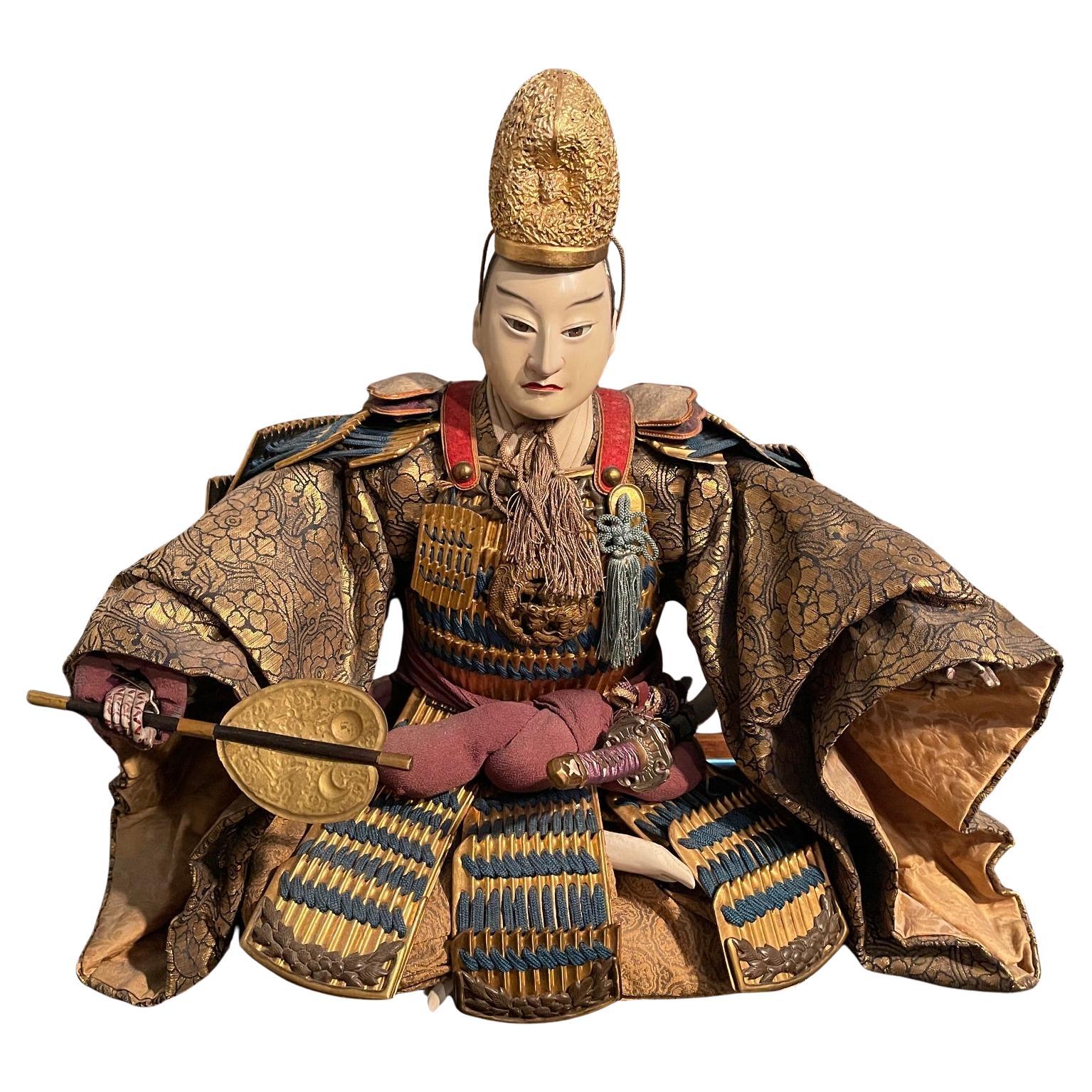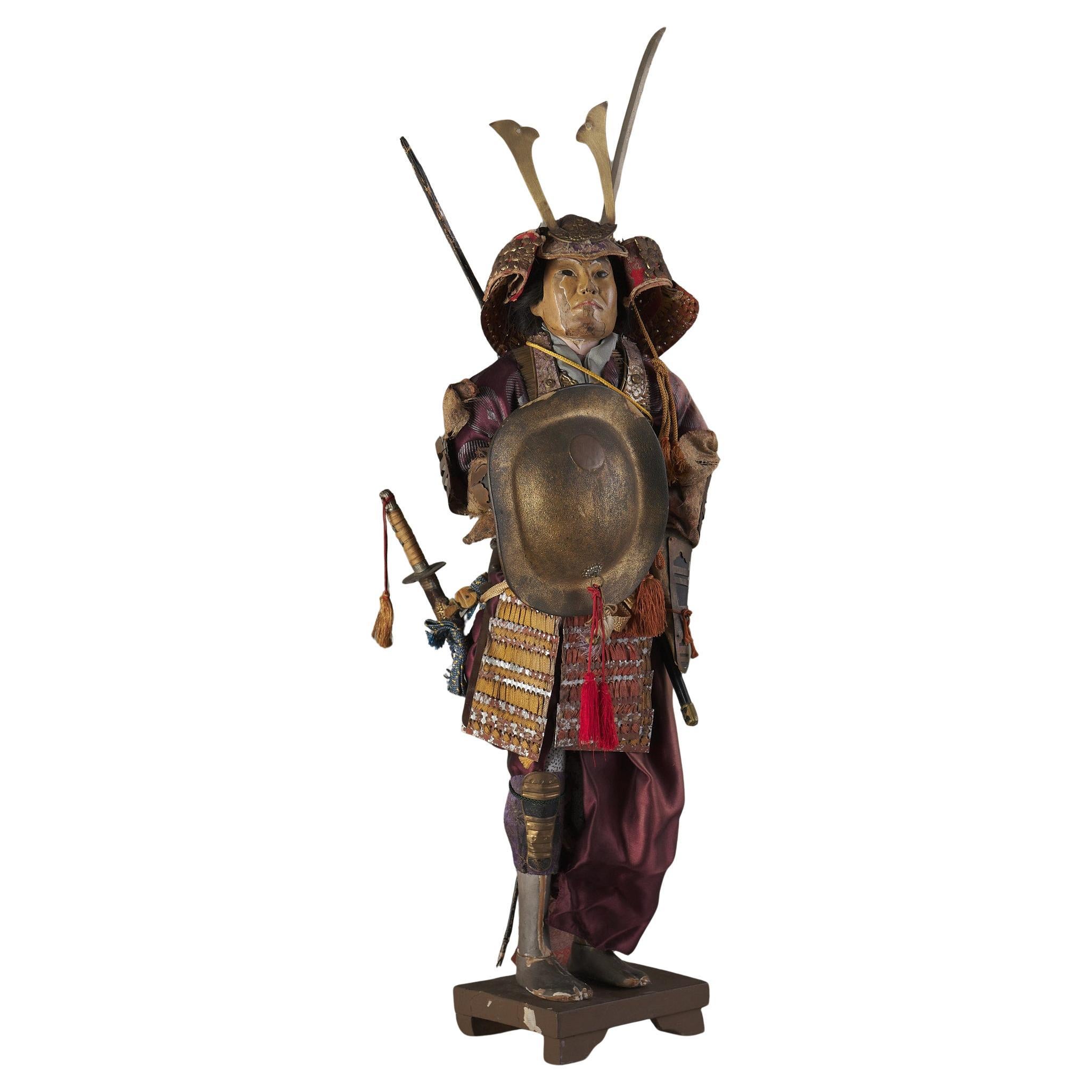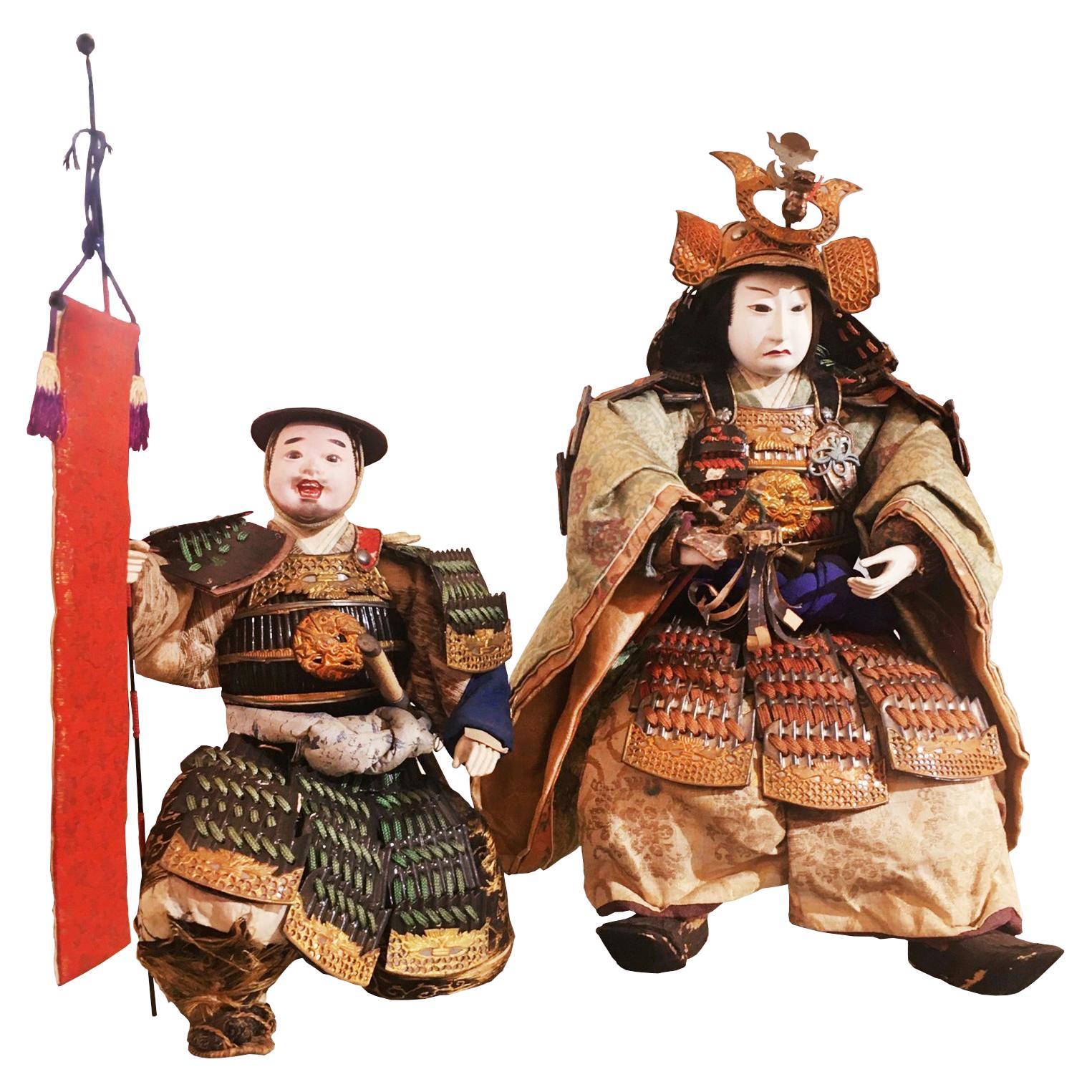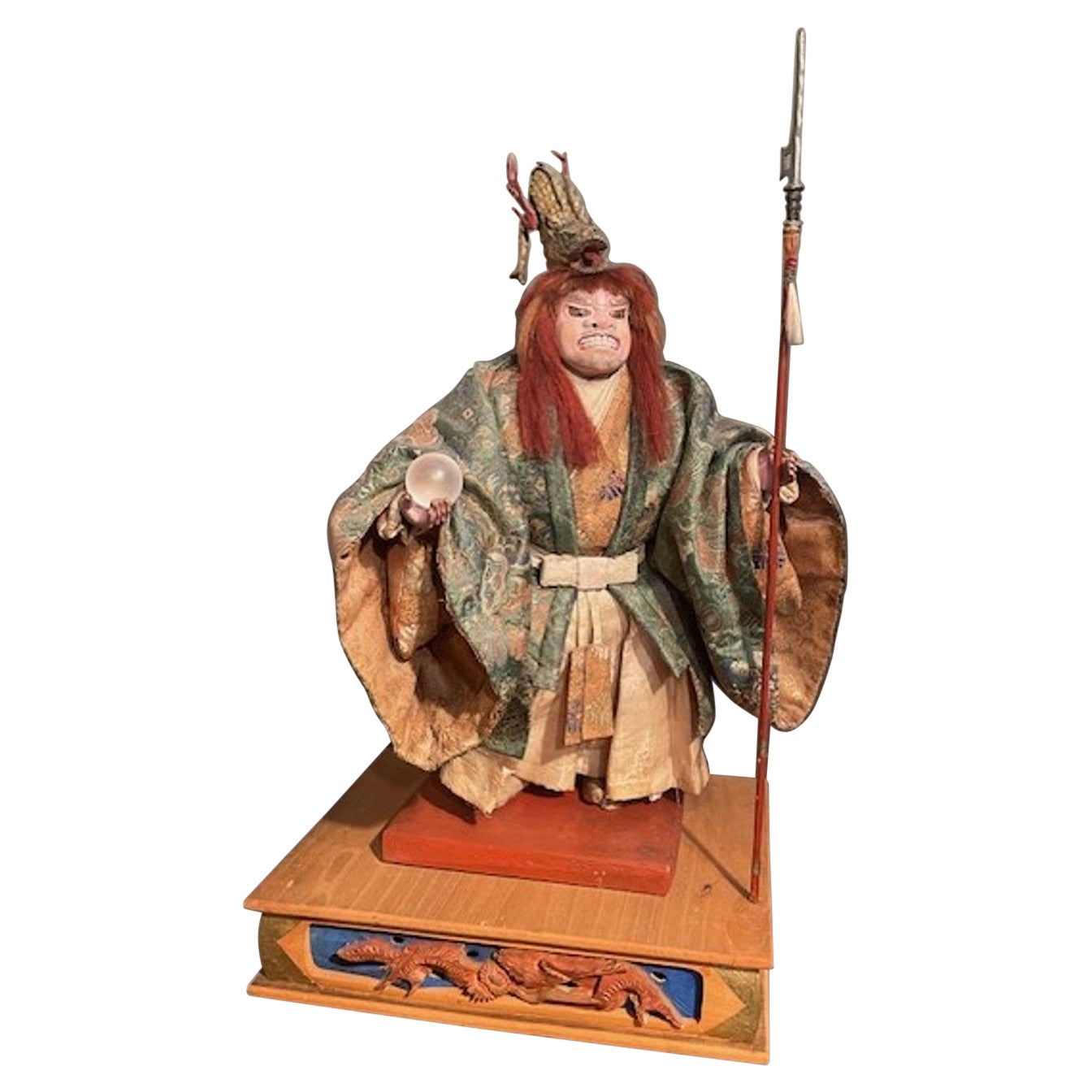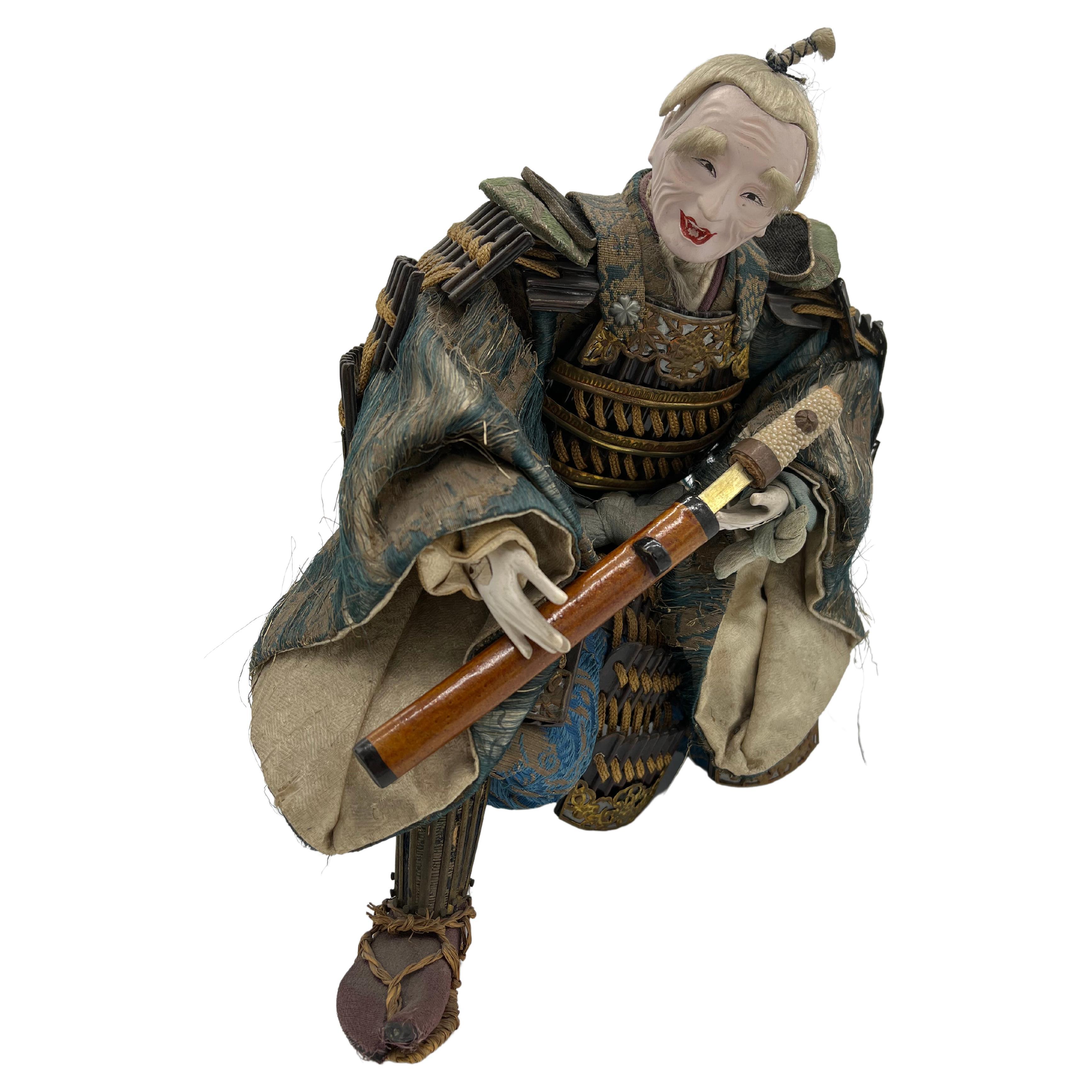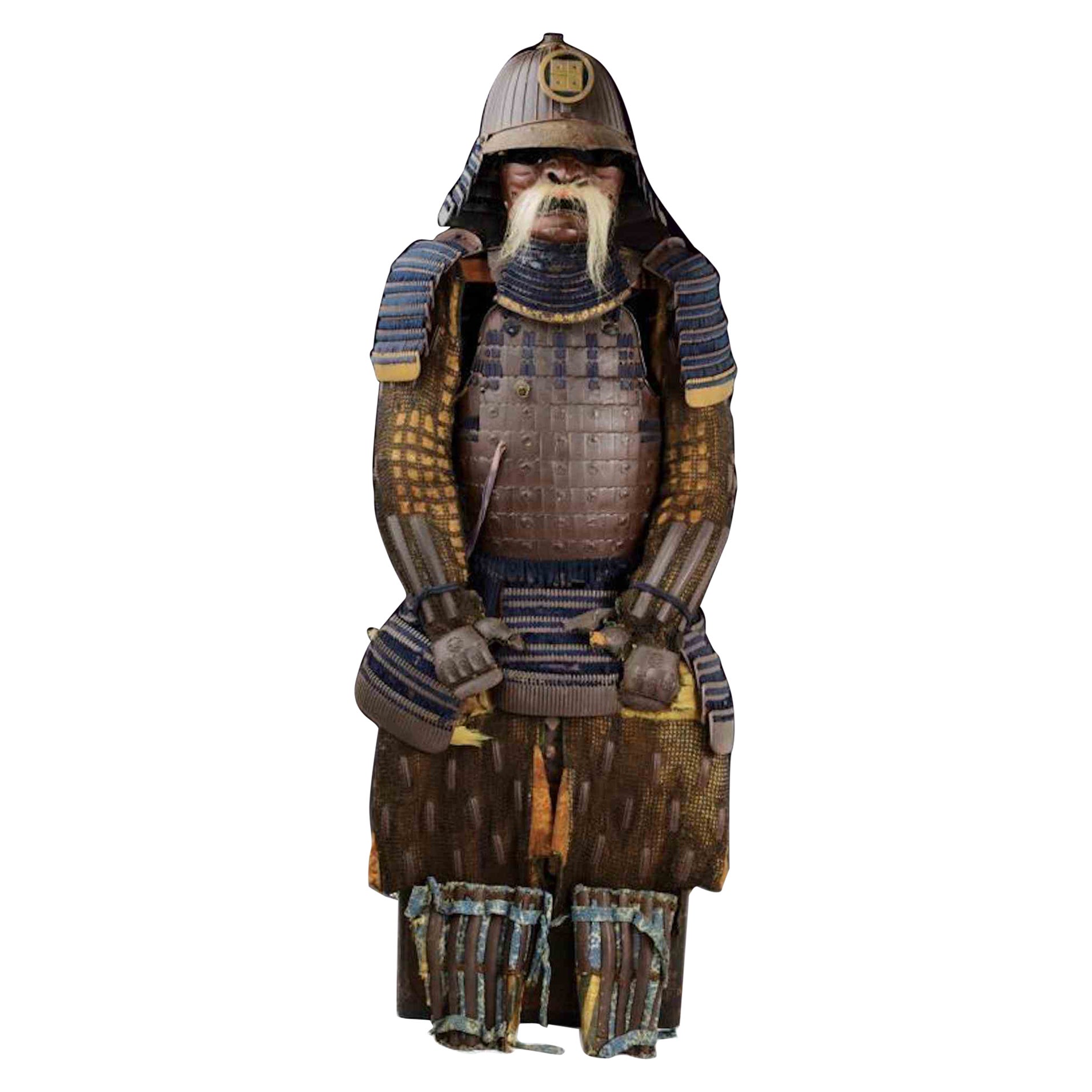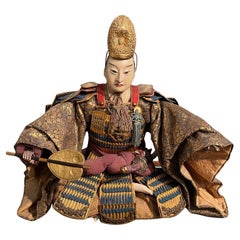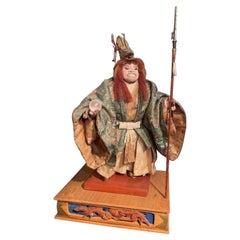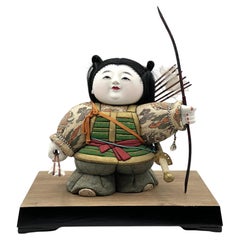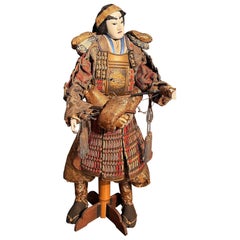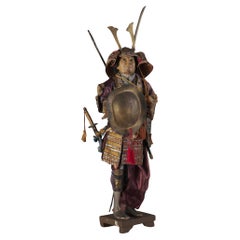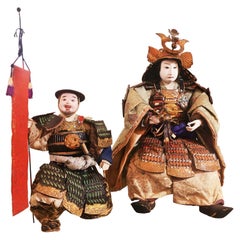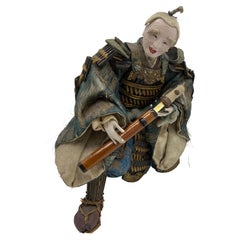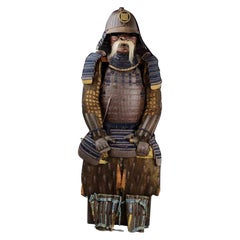Items Similar to Japanese Edo Period Yoshitsune and Bannerman Warrior Musha Ningyô, Ca. 1800
Want more images or videos?
Request additional images or videos from the seller
1 of 8
Japanese Edo Period Yoshitsune and Bannerman Warrior Musha Ningyô, Ca. 1800
$39,500
£29,783.17
€34,320.96
CA$54,797.18
A$61,399.95
CHF 31,961.01
MX$751,133.88
NOK 405,685.85
SEK 383,165.43
DKK 256,212.97
Shipping
Retrieving quote...The 1stDibs Promise:
Authenticity Guarantee,
Money-Back Guarantee,
24-Hour Cancellation
About the Item
Japanese Edo Period Grand-Scale Yoshitsune and Bannerman Warrior Musha Ningyô, Ca. 1800
DIMENSIONS
Warrior - Height: 31 inches with platform.
Bannerman - Height: 28 inches with banner.
ABOUT
Edo Period, early 19th century.
Boys’ day Ningyô is depicted as the 12th century general Minamoto no Yoshitsune (1159-89), accompanied by a kneeling Bannerman. Heads and hands carved of wood and covered in a fine white burnished gofun oyster shell lacquer, finely painted, well-carved and expressive features, and silk fiber hair worn long. wearing gold lacquer armor with silk lacing and sumptuous silk brocades, fur boots, battle whisk in his right hand, swords warning a magnificent winged helmet. On a display platform, The kneeling Bannerman is holding a silk banner with a Yoshitsune clan crest.
- Dimensions:Height: 31 in (78.74 cm)Width: 29 in (73.66 cm)Depth: 20 in (50.8 cm)
- Style:Japonisme (Of the Period)
- Materials and Techniques:
- Place of Origin:
- Period:
- Date of Manufacture:ca. 1800
- Condition:Wear consistent with age and use. We make our best effort to provide a fair and descriptive condition report. Please examine photos attentively, as they are part of the description. Send us a message to request more details or discuss price.
- Seller Location:New York, NY
- Reference Number:1stDibs: LU2819344673422
About the Seller
5.0
Vetted Professional Seller
Every seller passes strict standards for authenticity and reliability
Established in 1993
1stDibs seller since 2017
83 sales on 1stDibs
Typical response time: 7 hours
- ShippingRetrieving quote...Shipping from: New York, NY
- Return Policy
Authenticity Guarantee
In the unlikely event there’s an issue with an item’s authenticity, contact us within 1 year for a full refund. DetailsMoney-Back Guarantee
If your item is not as described, is damaged in transit, or does not arrive, contact us within 7 days for a full refund. Details24-Hour Cancellation
You have a 24-hour grace period in which to reconsider your purchase, with no questions asked.Vetted Professional Sellers
Our world-class sellers must adhere to strict standards for service and quality, maintaining the integrity of our listings.Price-Match Guarantee
If you find that a seller listed the same item for a lower price elsewhere, we’ll match it.Trusted Global Delivery
Our best-in-class carrier network provides specialized shipping options worldwide, including custom delivery.More From This Seller
View AllJapanese Edo Period Musha Ningyo Seating Samurai, Ca. 1800
Located in New York, NY
Japanese Edo Period Musha Ningyo Seating Samurai, Ca. 1800
DIMENSIONS
Height: 16 inches
Width: 19 inches
Depth: 10 inches
ABOUT
Musha Ningyō (武者人形)- Literal meaning: "Warrior Dolls...
Category
Antique Early 1800s Japanese Japonisme Figurative Sculptures
Materials
Wood
Japanese Edo Period Dragon God Ningyô, Ca. 1820
Located in New York, NY
Japanese Edo Period Dragon God Ningyô, Ca. 1820
DIMENSIONS
Height: 26 inches over all
Minor wear in textiles.
Fine antique condition
ABOUT
Musha-Ningyô (warr...
Category
Antique 1820s Japanese Japonisme Figurative Sculptures
Materials
Wood
Japanese Meiji Period Gosho Ningyô of the First Emperor, Jimmu, Ca. 190
Located in New York, NY
Japanese Meiji Period Gosho Ningyô of Jimmu, the First Emperor of Japan, Ca. 1900
DIMENSIONS:
Height: 8.5 inches
Widt...
Category
Antique Early 1900s Japanese Japonisme Toys and Dolls
Materials
Ceramic
Japanese Meiji Period Elaborate Bunraku Puppeta, 19th Century
Located in New York, NY
Japanese Meiji Period Elaborate Bunraku Puppeta. 19th Century
Meiji Period (1868-1912)
Minor wear to textiles, fine antique condition,
Original Bamboo display stand.
DIMENSION
Height: 33 inches
Width: 18 inches
Depth: 9 inches
ABOUT
Bunraku (puppet) depicting the warrior Minamoto Yoshistune his head carved of wood and covered in a fine white gofun with painted details, face of a handsome youth with trigger mechanism allowing for the eyebrows to raise and lower and the eyes to shift from side, is wearing military armor with signature dragon on his breastplate ,brocade patterning of his thick obi tie, sumptuous silk brocade kimono and brocade hakama trousers with the Minamoto Clan pattern, silk tabi socks...
Category
Antique Mid-19th Century Japanese Japonisme Figurative Sculptures
Materials
Wood
Japanese Edo Period Saga Ningyo, Ca. 1850
Located in New York, NY
Japanese Edo Period Saga Ningyo, Ca. 1850
DIMENSIONS
Height: 9.5 inches
Width: 6 inches
Depth: 5 inches
Category
Antique 1850s Japanese Japonisme Figurative Sculptures
Materials
Wood
Japanese Kimikomi Ningyô Doll by Important Artist Jinku-ru, Ca. 1920
Located in New York, NY
Japanese Kimikomi Ningyô Doll by Important Artist Jinku-ru, Ca. 1920
DIMENSIONS:
Height: 9.5 inches
Width: 5 inches
ABOUT
This exquisite Kimikomi Ningyo doll by Jinku-ru, a recog...
Category
Vintage 1920s Japanese Japonisme Toys and Dolls
Materials
Wood
You May Also Like
Gogatsu or 'Boys Day' Samurai 'Hero Doll', Japan, 1900
Located in Los Angeles, CA
The most elaborate samurai 'Hero' doll we've ever encountered and considering it's age, it's in amazing condition.
Category
20th Century Japanese Sculptures and Carvings
Materials
Steel
Samuraï Puppet Musha Nyngyo B Set of 2 Sculpture
Located in Paris, FR
Sculpture Samuraï Puppet Musha Nyngyo B Set of 2 with structure
in wood, hand-carved wood, hand-painted wood, hand-lacquered
wood, covered with hand-...
Category
Antique Early 1900s Japanese Figurative Sculptures
Materials
Silk, Wood
$5,687 / set
Japanese Samurai Figure Hinaningyo, Edo Period
Located in Munich, Bavaria
Antique samurai doll called Hinaningyo; Japan, late EDO period
Praised at the Tang-no-sekku boys' festival on May 5th as a sign of bravery, embodying the...
Category
Antique Mid-18th Century Japanese Antiquities
Materials
Textile, Wood
$2,710 Sale Price
20% Off
A Tosei Gusoku (Samurai's Armour), 17th Century
Located in Roma, IT
Belonging to the period 1603-1867, most likely between the end of 17th and the beginning of 18th Century, this beautiful armour is a 32-plate suji kabuto made of brown-lacquered iron...
Category
Antique 17th Century Japanese Figurative Sculptures
Materials
Metal, Iron
Samuraï Puppet Musha Nyngyo A Set of 2 Sculpture
Located in Paris, FR
Sculpture Samuraï Puppet Musha Nyngyo A Set of 2 with structure
in wood, hand-carved wood, hand-painted wood, hand-lacquered
wood, covered with hand-em...
Category
Antique Early 1900s Japanese Figurative Sculptures
Materials
Silk, Wood
$5,615 / set
Pair of Japanese Edo Period Musha Ningyo Courtier Dolls
Located in Austin, TX
Two exquisite Japanese musha ningyo dolls, crafted as courtiers, Edo Period, early 19th century, Japan.
The older man can be identified as the h...
Category
Antique Early 19th Century Japanese Edo Sculptures and Carvings
Materials
Shell, Brocade, Silk, Glass, Wood, Paint, Paper
More Ways To Browse
12th Century
Antique Kneeler
Wood Sword
Oyster Shell
Japanese Sword Furniture
Wood Warrior
Japanese Warrior
Used Oyster Shells
Antique Long Sword
Armor Helmet
Sword Display
Wood Kneelers
Antique Japanese Sword
Antique Japanese Swords
19th Century Japanese Wood Carving
Edo Period Carved Wood
Japan Armor
Japanese Armour
